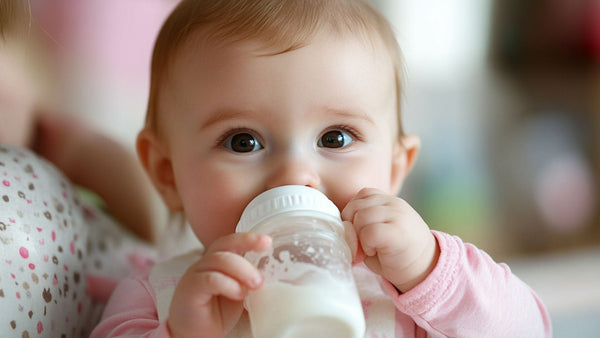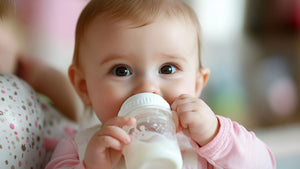Using Baby Formula in Bottles vs. Sippy Cups: When to Switch
Bottle or Sippy Cup for Formula? When and How to Make the Switch
Imagine: your little one is already a year old, but still clings to their bottle as if it were a lifeline. The neighbor's kids have been drinking from cups for ages, but your little one throws a tantrum at the sight of a sippy cup. Sound familiar? The bottle vs. sippy cup dilemma plagues millions of parents worldwide.
Dentists warn about "bottle tooth decay," pediatricians insist on a timely transition, and grandmothers shake their heads: "In our day, children drank from bottles until they were three years old!" However, when to transition from a bottle to a sippy cup is not just a matter of convenience. Behind this decision lie dental health, speech development, proper bite formation, and even the emotional maturity of the child. Where can you find the happy medium between your baby's comfort and their well-being?
Why Switch from Bottle to Sippy Cup (and Why Timing Matters)
Today, it's essential to introduce formulas correctly and use appropriate feeding tools for optimal results. Parents often ask "when to introduce a sippy cup" for their baby's comfort and developmental progress. Understanding the main reasons and pediatrician-recommended timing is crucial for successful transitions. Here is the essential information parents need:
-
Dental health concerns. Prolonged bottle use can cause tooth decay in baby teeth, leading to discomfort and oral health problems. Long-term bottle use can result in dental issues that affect babies' overall comfort and well-being.
-
Motor skill development. Bottles can interfere with the development of fine motor skills and hand-eye coordination in growing infants. Sippy cups are essential for preventing these developmental issues and promoting proper motor skill advancement.
-
Independence building. Transitioning to a sippy cup represents an important step toward independence and self-feeding capabilities. Babies can begin learning to drink and eat independently with parental guidance and support.
-
Optimal timing. Parents should understand "what age to start a sippy cup" for their babies' comfort and development. Pediatricians typically recommend starting the transition between 6 to 12 months for optimal tongue positioning.
-
Feeding control. Sippy cups help prevent overfeeding, which can negatively impact infant development and eating patterns. Children can better control their intake when using sippy cups, leading to improved eating habits.
Can You Give Baby Formula in a Sippy Cup? Yes — Here's How

Parents with growing babies often ask, "Can you put formula in a sippy cup?" The answer is yes - babies can safely receive formula in sippy cups. Pediatricians recommend starting this transition around six months for comfortable digestion and developmental readiness. Following specific steps correctly is crucial for successful transition and infant acceptance. Babies can gradually move away from bottles and develop independent feeding skills with proper guidance. Here are essential steps for effective transition:
-
Gradual introduction. Parents can begin by offering a sippy cup once daily to help babies adjust comfortably. Using quality formulas such as Kendamil, HiPP, and Holle provides excellent nutrition during transition periods.
-
Proper cup selection. Choosing appropriate sippy cups that feel comfortable for babies is essential for successful transitions. Cups should feature soft spouts or straws designed specifically for infant comfort and safety.
-
Understanding formula compatibility. Knowing that formula can be given in sippy cups helps parents plan smooth transitions. Parents should demonstrate proper cup tilting techniques and provide patient guidance during learning periods.
-
Age-appropriate formulas. Some formulas are suitable from birth to 12 months, making cup transitions easier for babies. The key for parents is maintaining patience and consistency during the bottle-to-cup transition.
-
Safety considerations. Parents should avoid allowing cup use in bed to prevent tooth decay and choking hazards. Careful attention and proper techniques help keep both babies and parents calm during transitions.
Seeking high-quality formulas for your child? Organic Life Start offers caring parents premium European formulas made from organic ingredients. Our products meet the strictest quality and safety standards, providing optimal nutrition for your child's healthy development.
When to Start a Sippy Cup for Breastfed or Bottle-Fed Babies
Parents should understand "when to start a sippy cup for a breastfed baby" for optimal comfort and development. Pediatricians recommend introducing sippy cups around six months for proper developmental readiness and motor skills. Proper transitions promote independence and improve babies' comfort with self-feeding and drinking skills. For breastfed babies, sippy cups serve as valuable tools for developing independence and weaning preparation. This transition helps babies move away from exclusive breastfeeding while maintaining nutritional needs effectively.
Transitioning from bottles to sippy cups helps reduce dental risks and represents the best developmental option. Understanding when babies need this transition helps parents recognize optimal timing for introduction. Here are key signs of readiness for sippy cup introduction:
-
Independent sitting. Parents can recognize readiness "when to introduce a sippy cup to baby" when infants sit independently. When babies need minimal head and back support, they're ready for sippy cups.
-
Object manipulation. Babies can independently hold and grasp various objects, indicating readiness for cup handling. This represents the most reliable sign of developmental readiness for sippy cup transitions.
-
Imitation behaviors. Children can observe and copy adult behaviors and actions during daily activities. Babies who imitate adult drinking motions demonstrate readiness for sippy cup introduction.
-
Solid food consumption. Another indicator involves babies consuming pureed or solid foods alongside their parents regularly. Oral-motor development progression requires transitioning from bottles to cups for continued independence and growth.
How to Transition from Bottle to Sippy Cup Without the Fuss

Parents should understand "how to transition a baby from bottle to sippy cup" effectively and patiently. While transitions may seem complicated, patience and consistency make the process manageable for families. Gradual approaches and patience help make transitions stress-free for both babies and parents. Step-by-step strategies are essential for easy transitions without additional stress or complications. Here are fundamental tips for success:
-
Optimal timing. Begin transitioning babies between six to nine months for comfort and developmental appropriateness. Babies can start holding their heads independently and show interest in other people's actions.
-
Gradual replacement. A good approach is replacing one bottle feeding at a time with sippy cup vs bottle feedings. Parents can use breast milk or familiar formula in sippy cups for babies' comfort.
-
Mealtime integration. Understanding sippy cup benefits helps parents recognize children's preferences and developmental needs. Sippy cups can be introduced during solid food meals or puree feedings for familiarity.
Tips to Help Baby Accept a Sippy Cup (Even If They Resist)
Anyone can contact us for information about quality nutrition and feeding guidance for growing babies. Parents should understand "how to get a baby to drink from a sippy cup" correctly and effectively. Several practical steps help babies accept sippy cups even when they initially resist the change. Sometimes encouraging babies to drink becomes challenging because they're accustomed to bottles and familiar routines. These practical tips help make transitions easy and successful for resistant babies. Here is essential information for success:
-
Appropriate cup features. Using sippy cups with comfortable spouts designed for babies is fundamental for acceptance. Cups with soft silicone spouts help babies transition comfortably from bottles to independent drinking. Parents can choose attractive designs and colors that appeal to babies and encourage interest.
-
Familiar liquids. Another strategy for "how to get a baby to use a sippy cup" involves using familiar liquids. Breast milk or regular formula from bottles helps babies accept sippy cups more readily. Playing songs or music can help distract babies during the transition period.
-
Positive modeling. Parents should demonstrate proper cup use and show babies how to drink independently from cups. Consistency and patience help make transitions smooth and stress-free for developing babies. Celebrating successes and providing encouragement creates positive associations with sippy cup use.
Organic Life Start is committed to providing accurate, reliable, and trustworthy information to parents and caregivers. We carefully choose credible sources and follow a meticulous fact-checking process to uphold the highest standards in infant nutrition and parenting advice. To learn more about our dedication to accuracy, please explore our editorial guidelines.
Link To Sources







